LANL’s Toxic Hexavalent Chromium Plume Must Remain a Priority
![]() CCNS provided the following response to a recent Santa Fe New Mexican Our View:
CCNS provided the following response to a recent Santa Fe New Mexican Our View:
“In response to Stop Stalling: Clean up chromium plume, no one is stalling. [Posted below.] The plume does need immediate attention and does need to be analyzed with a computer model that everyone can use. The consequences of getting the cleanup of the toxic hexavalent chromium plume wrong would be disastrous.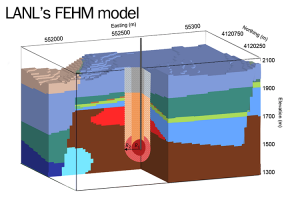
“CCNS urges that before the proposed negotiations between the Department of Energy (DOE) and the New Mexico Environment Department (NMED) take place, a comparison is made of the differing groundwater models they use.
“CCNS suggests that groundwater monitoring data from 2016 forward be entered into both the USGS MODFLOW model and LANL’s own FEHM model and compared. [We are suggesting the 2016 date because that is when the NMED groundwater discharge permit for the extraction and injection processes was issued. GWDP No. 1835.]
“CCNS first suggested this approach as far back as 1998, when the first groundwater monitoring well was installed under LANL’s Hydrogeological Workplan. Over the decades, CCNS has witnessed the long-standing resistance by LANL to use MODFLOW.
 “Water is too precious to put its purity at risk. The toxic hexavalent chromium plume below LANL was discovered in 2004. [http://www.nuclearactive.org/news/122206.html] The big question right now is whether the injection of treated water is pushing, or smearing, the contamination deeper into the regional drinking water aquifer.
“Water is too precious to put its purity at risk. The toxic hexavalent chromium plume below LANL was discovered in 2004. [http://www.nuclearactive.org/news/122206.html] The big question right now is whether the injection of treated water is pushing, or smearing, the contamination deeper into the regional drinking water aquifer.
“This is a big deal. To reach the drinking water aquifer where the hexavalent chromium is found, the wells must be at least 1,000 deep. Those wells extract, or pump, the waters to the surface where they are run through large filters to remove the pollutants. The waters are then injected back into the aquifer to create a hydrologic barrier to keep the plume from moving. But NMED has concerns that the injection is moving the existing contamination deeper into the aquifer. In the early days of this effort, the hexavalent chromium was found in the top 50 feet of the aquifer. Now LANL says it is in the top 150 feet of the aquifer, creating an impasse between NMED and DOE.
“Importantly, the plume is sitting on the west side of the Española Basin Sole Source Drinking Water Aquifer. In 2008, the Environmental Protection Agency found that 85% of the drinking water in the 3,000 square mile designated area comes from wells in the aquifer. The importance of getting the cleanup right cannot be understated. http://nuclearactive.org/ccns-urges-state-legislature-to-protect-the-espanola-aquifer-from-lanl-pollutants/
“On August 21st, the New Mexico Legislature’s Radioactive and Hazardous Material Committee met in Los Alamos. The toxic plume was on the agenda. A suggestion was made to bring in an independent negotiator to break the impasse. This is a good idea. [https://www.nmlegis.gov/committee/Interim_Committee?CommitteeCode=RHMC, see agenda and DOE and NMED handouts. See webcast at https://sg001-harmony.sliq.net/00293/Harmony/en/PowerBrowser/PowerBrowserV2/20230831/-1/73647 ]
“But LANL does not use the most widely accepted and used groundwater model created by the U.S. Geological Survey, called MODFLOW. LANL uses its own groundwater model, called FEHM, which stands for Finite Element Heat and Mass Transfer Code. But to use FEHM, you have to register at https://fehm.lanl.gov/. Today, August 31st, the registration links aren’t working. 
“The USGS MODFLOW is “considered an international standard for formulating and predicting groundwater conditions and groundwater/surface water interactions.” Most water professionals use MODFLOW to protect water from contamination. It is a computer model that is publicly available without the need to register. https://www.usgs.gov/software/modflow-6-usgs-modular-hydrologic-model
“A complete investigation of the movement of the hexavalent chromium in the aquifer will reveal if it has spread into the Española Basin SSA. To break the impasse, a comparison of the two groundwater models using the same data is required now.”
Santa Fe New Mexican Our View
Stop stalling: Clean up the chromium plume
- Aug 23, 2023 Updated Aug 24, 2023
New Mexico has no time for standing still when it comes to cleaning up a decades-old toxic chromium plume under Los Alamos National Laboratory.
The disagreement between federal and state officials over how best to clean the tainted water must be resolved. Now. At a recent meeting of the state Legislature’s Radioactive and Hazardous Materials Committee, lawmakers learned the cleanup is stalled.
State regulators in March ordered the U.S. Energy Department to cease its extraction of tainted water, which was followed by treatment and a reinjection into a 1.5-mile-long plume. The process is designed to dilute the pollution, but state experts believe reinjecting the water only pushes the contaminants toward San Ildefonso Pueblo and deeper into the aquifer. The pollution isn’t only a concern for the pueblo; residents of long established villages and farmers in the area also want to know the contamination has been removed.
Federal officials say their pump-treat-return method is working. It, they maintain, reduces the hexavalent chromium and builds a “hydraulic barrier” that keeps it from spreading.
Despite disagreeing with state action, the Energy Department ceased injecting treated water back into the aquifer in April. Now, its experts are worried whatever cleaning has occurred will be compromised. Michael Mikolanis, head of the department’s environmental management at Los Alamos, told lawmakers the chromium plume once more is moving since the cleanup stopped.
Not so fast, says the state. Rick Shean, state Environment Department director of resource protection, says monitoring wells have revealed the injections are neither containing the pollutants nor pulling them back. The process doesn’t work.
Whom to believe?
We’ll go with a third party, as suggested by state Sen. Jeff Steinborn, D-Las Cruces. He wanted to know if the feds and the state would consider mediation by an outside expert. The Energy Department has money to pay an independent analyst, who Mikolanis said would be impartial even if paid through a government grant. For the cleanup to be completed, the process cannot drag out.
Meanwhile, as Shean points out, extraction can continue — just without reinjecting the water. Federal cleanup managers say that isn’t feasible.
Truth be told, LANL and the Department of Energy have been poor partners over the years in cleaning up messes. If they truly were trying to remove legacy waste as quickly and efficiently as possible, the state of New Mexico wouldn’t have had to resort to going to court repeatedly.
Residents of Northern New Mexico deserve to have removal of pollutants — especially those contaminating water sources — at the top of the priority list for the Department of Energy. Mikolanis maintains workers can’t amp up extraction any more than the consent order calls for, but here’s a thought: What’s wrong with doing more than required?
Federal cleanup authorities should stop trying to do the minimum.
The state is suing the Department of Energy over the terms of the cleanup. A 2016 consent order between the state and federal agencies, struck under then-Gov. Susan Martinez, is deficient and state officials are seeking to move the work along. That’s the right approach.
In the meantime, get an analyst in to see whether reinjection of water is worsening the pollution. Keep pulling water out while that analysis is completed — after all, hexavalent chromium is a known carcinogen.
Stop wasting time.
- Friday, September 1st from noon to 1 pm MT –
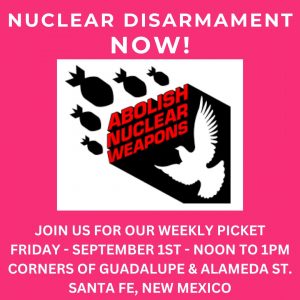 Join the weekly peaceful protest for nuclear disarmament on the corners of Alameda and Guadalupe in downtown Santa Fe with Veterans for Peace, CCNS, Nuclear Watch NM, Loretto Community, Pax Christi, Nonviolent Santa Fe, and others.
Join the weekly peaceful protest for nuclear disarmament on the corners of Alameda and Guadalupe in downtown Santa Fe with Veterans for Peace, CCNS, Nuclear Watch NM, Loretto Community, Pax Christi, Nonviolent Santa Fe, and others.
Come and visit with us about planning Defuse Nuclear War events (Sept. 24 – 30 Week of Action) and the Back from the Brink campaign. Pick up Back from the Brink materials to support work to prevent nuclear war. https://preventnuclearwar.org/
- Friday, September 1st at noon
 on the east side of the Roundhouse, Rick Hubbard, an 82-year old retired lawyer and peace activist, will speak about his Walking Across America to Fix Our Democracy. He will speak about his efforts to raise Americans’ awareness of the danger we are facing and to build a movement to Fix Our Democracy now. https://www.fixourdemocracy.us/santa-fe-nm
on the east side of the Roundhouse, Rick Hubbard, an 82-year old retired lawyer and peace activist, will speak about his Walking Across America to Fix Our Democracy. He will speak about his efforts to raise Americans’ awareness of the danger we are facing and to build a movement to Fix Our Democracy now. https://www.fixourdemocracy.us/santa-fe-nm
- Friday, September 22, 2023 from 5 to 7 pm MT –
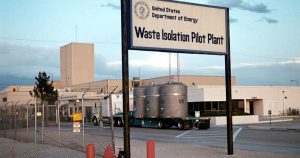 NM Environment Department hybrid public meeting to present the changes made to the draft hazardous waste permit as represented in the proposed 10-year final permit for the Waste Isolation Pilot Plant (WIPP). The public is invited to ask questions to NMED and WIPP representatives and make public comments. For more information, see the August 15, 2023 public notice. https://hwbdocuments.env.nm.gov/Waste%20Isolation%20Pilot%20Plant/230818.pdf
NM Environment Department hybrid public meeting to present the changes made to the draft hazardous waste permit as represented in the proposed 10-year final permit for the Waste Isolation Pilot Plant (WIPP). The public is invited to ask questions to NMED and WIPP representatives and make public comments. For more information, see the August 15, 2023 public notice. https://hwbdocuments.env.nm.gov/Waste%20Isolation%20Pilot%20Plant/230818.pdf
Three ways to attend the public meeting:
Carlsbad in-person location: Skeen-Whitlock Bldg., 4021 National Parks Hwy.
Santa Fe in person location: Larrazolo Auditorium, NMED Harold Runnels Bldg., 1190 St. Francis Drive (between Cordova and Alta Vista).
Remote Access on WebEx: https://www.env.nm.gov/events-calendar/?trumbaEmbed=view%3Devent%26eventid%3D167732347
Three ways to submit public comments:
NMED Public Comment Portal: https://nmed.commentinput.com/?id=G5E7C
Email to Megan.McLean@env.nm.gov
Postal Mail: Megan McLean, Acting WIPP Group Program Manager
Hazardous Waste Bureau – NM Environment Department
2905 Rodeo Park Drive East, Bldg. 1
Santa Fe, NM 87505-6303
- Sign the Tewa Women United petition to Protect Vulnerable NM Communities: Halt Radioactive Tritium Release from LANL.
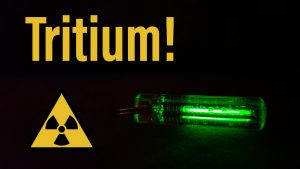 LANL is proposing to vent four flanged tritium waste containers (FTWCs) by September 30, 2023 (the end of the fiscal year). https://tewawomenunited.org/2023/08/its-happening-again-petition-to-halt-lanls-planned-tritium-release
LANL is proposing to vent four flanged tritium waste containers (FTWCs) by September 30, 2023 (the end of the fiscal year). https://tewawomenunited.org/2023/08/its-happening-again-petition-to-halt-lanls-planned-tritium-release
- Trinity: Legacies of Nuclear Testing –
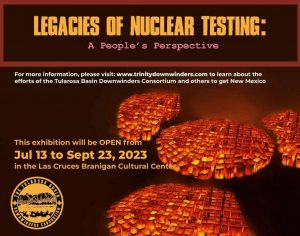 A People’s Perspective Art Exhibit at the Branigan Cultural Center, 501 N. Main Street, Las Cruces, NM. The exhibit will be up until September 23, 2023. https://www.lascruces.gov/1528/Branigan-Cultural-Center
A People’s Perspective Art Exhibit at the Branigan Cultural Center, 501 N. Main Street, Las Cruces, NM. The exhibit will be up until September 23, 2023. https://www.lascruces.gov/1528/Branigan-Cultural-Center
Tags: Department of Energy, DOE, DP-1835, Environmental Protection Agency, EPA, Española Basin Sole Source Drinking Water Aquifer, Española Basin System, FEHM, Finite Element Heat and Mass Transfer Code, hexavalent chromium, LANL, LANL Hydrogeological Workplan, Los Alamos National Laboratory, New Mexico Environment Department, New Mexico Legislature, New Mexico Legislature’s Radioactive and Hazardous Materials Committee, NMED, Santa Fe New Mexican Our View, Stop Stalling: Clean up chromium plume, U.S. Geological Survey MODFLOW


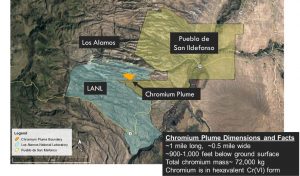

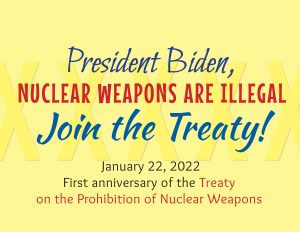
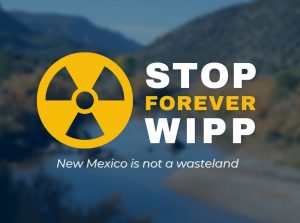






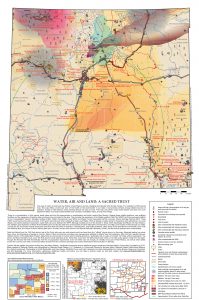

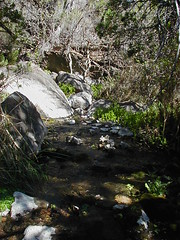

Comments
No comments so far.